As the salty water crashes on the Italian coastline, fresh seafood is being caught to be enjoyed by locals, restaurant goers, and families alike. “Frutti di mare” literally translates from Italian to “fruit of the sea.” The abundance of seafood makes it a culinary staple in coastal regions for Italians rich and poor. Seafood is often best when kept simple, the approach Michael Vincent Ferreri, chef at cafe/BYOB Res Ipsa, takes when preparing his frutti di mare dishes. This week we had the pleasure of hosting Michael and his team at Res Ipsa as they put on an Italian seafood feast, featuring shrimp, swordfish, monkfish, and a pasta with octopus and squid ink which guests adored. Read on for seafood advice and learn about how to use some lesser known frutti di mare from the talented Michael Vincent Ferreri of Res Ipsa!
General Seafood Tips and Cooking Advice
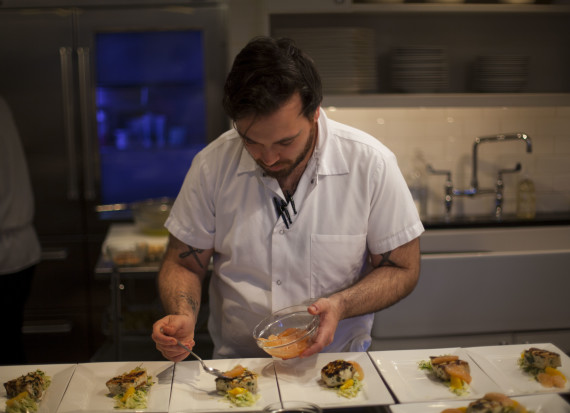
From chef Michael Vincent Ferreri
The name Res Ipsa derives from the latin phrase res ipsa loquitur, meaning the thing speaks for itself. I would argue that this is also the underlying principle in Michael Vincent Ferreri’s cooking. Michael started off his class by telling COOK guests a quick story about how his former boss at Zeppoli, Joey Baldino, taught him the most important lesson of his culinary career. One day Joey asked Michael to prepare some sardines. Michael jumped at the opportunity and asked what else he wanted to have prepared with the sardines. Joey stunned him when he told him to simply grill them with some olive oil and lemon. That’s when Michael realized you can’t mask mistakes in a dish when keeping it simple – you have to do it right. According to Michael, this is also the philosophy in Sicilian cuisine. So when it comes to cooking seafood Michael’s style is exactly what he learned from grilling those sardines: let the fish shine and use ingredients that highlight the salty ocean-like flavor.
Additionally, Michael stressed to always buy the freshest seafood possible, the flesh should be firm, not slimy and it should smell like the ocean, not fishy. And while Michael is deeply influenced by his Italian heritage, he also said he likes to “take tradition and f*ck with it hard”. So don’t be afraid to put your own spin on these seafood dishes, just don’t go too crazy and don’t overcomplicate it.
Sepia (Squid Ink)
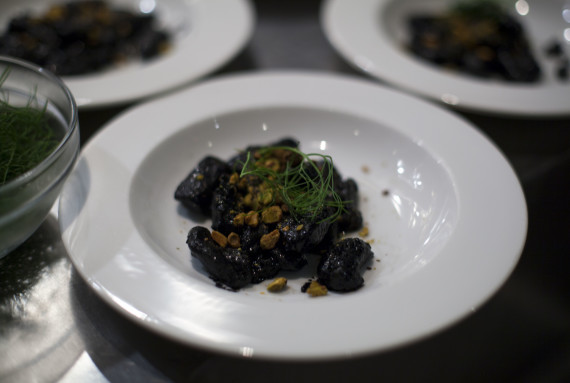
Cavatelli with sepia, pistachio and basil
If you’ve ever been to an Italian restaurant and seen a plate of squid ink pasta coming out of the kitchen you know just how eye-catching it is. The pure black color is beautiful and striking. While this dish is certainly impressive, cooking with squid ink is not as intimidating as you may think. Squid ink, or sepia as chef Michael referred to it, is easy to use and extremely versatile. During its dinner hours, Res Ipsa serves a dish that has a sepia agrodolce that functions as a tart dipping sauce for the star of the plate, fried squid. Essentially, the squid ink acts as a concentrated flavor, instantly transforming any dish with its bold black color and salty bite. It is essentially a waste product that the squid produces as a defense mechanism. The cephalopods intake sea water and process it through their body to create the “ink”. Therefore it is very salty and has that fresh ocean taste while not being overly fishy. Sepia has a long shelf life, making it a great addition to any pantry. You can order it online, or if you are in the city, Michael suggests checking out Ippolito’s Seafood in South Philly at 13th and Dickinson. Most restaurants in the city, including Res Ipsa, use Samuels & Son Seafood Co. (the parent company of Ippolito’s) as their seafood supplier because because of their incomparably fresh offerings. However, they are a wholesale operation making it unreachable for home cooks. Ippolito’s serves as a storefront business for home cooks to get the same quality seafood that Samuels provides to restaurants.
Swordfish
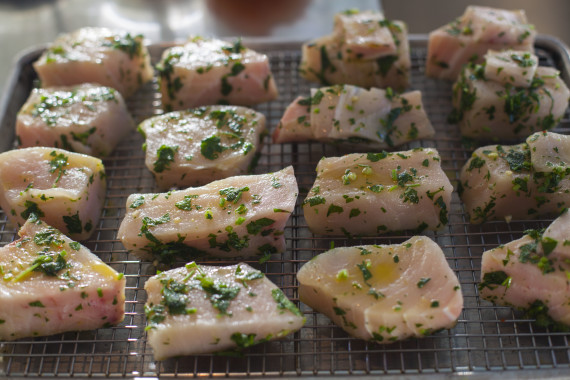
Cuts of swordfish marinated with olive oil, fennel and citrus
Contrasting from the dark squid ink pasta were the light and bright cuts of swordfish. A straightforward marinade of olive oil, fennel, and citrus made the pinkish flesh shine, both literally and figuratively. Black olives were served with the swordfish because Michael said the bitterness from them balances out the gentle sweetness of the swordfish. Michael expressed that swordfish is one of his favorite fishes because it is more balanced salt-wise. The Res Ipsa crew grilled it up, Michael’s preferred method of cooking seafood because the high heat helps maintain freshness.
Monkfish
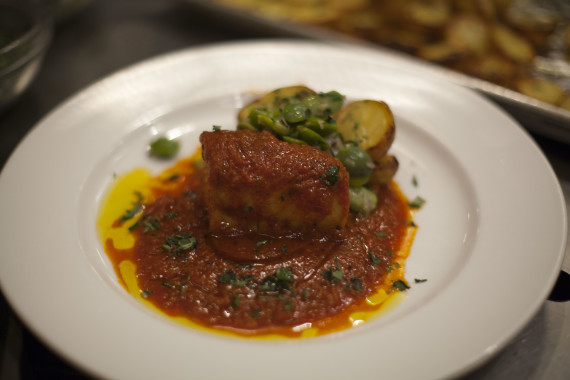
Lastly, Michael gave COOK guests a taste of the not-so-pretty but delicious monkfish. Sourced from New Jersey, Michael bought just fillets instead of buying the whole fish as he usually does because monkfish are quite boney and you cannot use much else on them. Dubbed the “poor man’s lobster” due to its light flavor and similar texture, monkfish have a firm exterior and therefore are pretty forgiving. Chef Michael braised the monkfish ahead of time in order to develop more flavor. It’s hard to over-braise monkfish, but ultimately you want it to be flaky, not mushy. Braised in their house red sauce with slowly confited onions, basil and Calabrian chilies, the monkfish became extremely tender and rich.
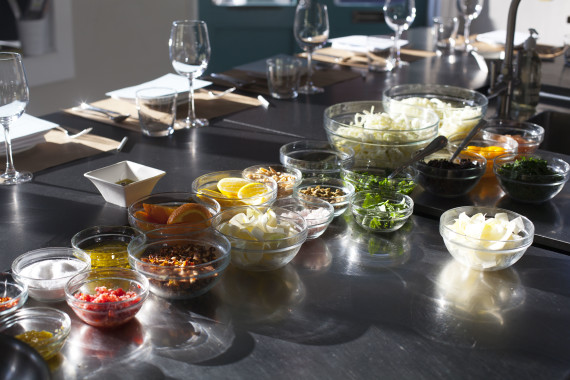
With the sun’s return and rising temperatures, eating seafood can help you eat lighter and healthier. Now that you’re armed with this newfound seafood knowledge, you can branch out from the usual salmon, shrimp and tuna. Ippolito’s Seafood has fresh seafood and will have more obscure offerings such as squid ink. You can always ask them to order it for you as well. Get creative, but remember Michael’s key advice – keep it simple and let the fresh fish shine!
Back to Blog



